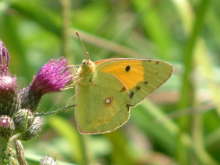
| Butterfly Conservation |
 |
| Hertfordshire & Middlesex Branch |
 |
|
|||
| Saving butterflies, moths and our environment | ||||


Clouded YellowColias croceusLess common migrant Distribution and Status The Clouded Yellow is an immigrant but numbers arriving each year vary enormously largely determined by weather conditions in southern Europe. Recently, there is some evidence that some individuals overwinter successfully as larvae or pupae in the extreme south of the country but most perish and die in the cold. There is no evidence of any such successful overwintering in our branch area Habitat Requirements Almost anywhere where there is an abundance of nectar sources. Clover fields are one of its favourite habitats Larval Foodplants Red Clover Trifolium pratense, White Clover Trifolium repens, Clover spp. Trifolium spp. Other possible foodplants include Lucerne Medicago sativa, Bird's-foot Trefoil Lotus corniculatus and Goat's Rue Galega officinalis Adult Food Sources Dandelion Taraxacum spp., Buddleia Buddleja davidii, Common Knapweed Centaurea nigra, Spear Thistle Cirsium vulgare Behaviour/Observation notes Its quick flight and usual reluctance to settle long on a flower can make it difficult to get close and take a decent close-up photograph. Males are normally more active so seeking out females egg-laying in clover fields may present better opportunities Life History A few specimens visit Britain in the early summer in most years but most are recorded from August, the offspring of the early arrivals augmented by more immigrants from Europe. Eggs are laid singly on the leaves of the foodplant and hatch in about a week. Larvae spend about a month depending upon temperatures before forming pupae attached to the foodplant Further information
UK distribution map |
Copyright Butterfly Conservation © 2019 Hertfordshire & Middlesex Branch
Privacy and Copyright Statement and Cookie Policy Statement
Butterfly Conservation
Company limited by guarantee, registered in England (2206468)
Registered Office: Manor Yard, East Lulworth, Wareham, Dorset, BH20 5QP. Tel: 01929 400 209
Charity registered in England & Wales (254937) and in Scotland (SCO39268). VAT No. GB 991 2771 89